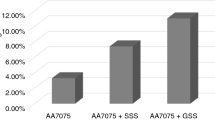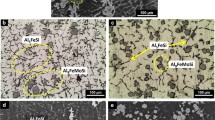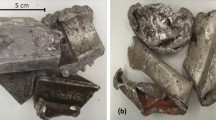Abstract
Recycling of aluminum scrap has gained interest owing to its economic and ecological benefits. Unfortunately, during the collection of scrap from a mixer of junk from various sectors it is difficult to ensure that the recycled alloy has the same chemical composition as that of already existing commercial alloys. Consequently, some of the alloying elements become trace/tramp elements in the recycled alloy. Therefore, in order to obtain high performance recycled alloys, controlling the impurity levels of the aluminum melt is of vital importance. Normally, computer aided cooling curve analysis (CA-CCA) is used to find the relationship between cooling curve parameters, melt treatments, alloy composition, and properties. In the present study, the first differential thermal analysis (DTA) approach has been used to detect and quantify impurity elements in scrap-like liquid aluminum alloys.






Similar content being viewed by others
References
Mahfoud M. Controlled thermal analysis using heat pipe technology. PhD Thesis, McGill University, 1997.
Khalifa W, Samuel FH, Gruzleski JE. Nucleation of solid aluminum on inclusion particles injected into Al–Si–Fe alloys. Metall Mater Trans. 2003;34A:807–25.
Rilvin VG, Raynor GV. Critical evaluation of constitution of aluminum–iron–silicon system. Int Metall Rev. 1981;3:133–52.
Narayanan A, Samuel FH, Gruzleski JE. Crystallization behaviour of iron-containing intermetallic compounds in 319 aluminium alloy. Metall Mater Trans. 1994;25A:1761–73.
Sreeja Kumari SS, Pillai RM, Rajan TPD, Pai BC. The effects of individual and combined additions of Be, Mn, Ca and Sr on the solidification, structure and mechanical properties of Al–7Si–0.3Mg–0.8Fe alloy. Mater Sci Eng. 2007;460-461A:561–73.
Prasada Rao AK, Das K, Murty BS, Chakraborty M. Prediction of grain size of Al–7Si alloy by neural networks. Mater Lett. 2008;62(2):273.
Prasada Rao AK, Das K, Murty BS, Chakraborty M. Al-Ti-C-Sr master alloy - A melt inoculant for simultaneous grain refinement and modification of hypo-eutectic Al-Si alloys. J Alloys Compd. 2009; 480(2):L49–51.
Mahfoud M, Emadi D. Advances in materials and processing technologies (AMPT) conference. Manama, Kingdom of Bahrain, Nov; 2008.
Mahfoud M, Emadi D. 2nd International aluminum casting conference & exhibition, Moscow, Russia, April 1–3; 2009.
Emadi D, Whiting LV. Determination of solidification characteristics of Al-Si alloys by thermal analysis. AFS Trans. 2002; 110(1):285–96
Fornaro O, Palacio HA. Study of dilute Al–Cu solidification by cooling curve analysis J Mater Sci. 2009; 44(16):4342–4347.
Emadi D. In: Proceedings of the 12th annual technical meeting & exhibition of the Canadian thermal analysis society (CTAS), Mississauga, Canada, 14–15 May 2002; p. 58.
Pelayo G, Sokolowski JH, Lashkari R. A case based reasoning aluminium thermal analysis platform for the prediction of W319 Al cast component characteristics. J Achiev Mfg Eng. 2009; 36(1):7–17.
Malekan M, Shabestari SG. Effect of grain refinement on the dendrite coherency point during solidification of the A319 aluminum alloy. Metall Mater Trans. 2009;40A:3196–203.
Mahfoud M, Emadi D. Application of heat pipe technology in thermal analysis of metals. J Therm Anal Calorim. 2005;81:161–7.
Mackay RI. Quantification of iron content in Al–Si foundry alloys via thermal Analysis. Master’s Thesis, McGill University, 1996.
Phillips HWL. Institute of Metals Monograph and Report Series, 1959; No. 25: p. 56.
Phillips HW. Annotated equilibrium diagrams of some aluminum alloy systems. London: The Institute of Metals; 1976.
Acknowledgements
The authors would like to express their appreciation to Qatar National Research Fund for their financial support. The technical assistance of the staff at Qatar University (Department of Mechanical and Industrial Engineering), McGill University (Department of Materials Engineering) and College of North the Atlantic-Qatar is very much appreciated.
Author information
Authors and Affiliations
Corresponding author
Rights and permissions
About this article
Cite this article
Mahfoud, M., Prasada Rao, A.K. & Emadi, D. The role of thermal analysis in detecting impurity levels during aluminum recycling. J Therm Anal Calorim 100, 847–851 (2010). https://doi.org/10.1007/s10973-010-0742-8
Published:
Issue Date:
DOI: https://doi.org/10.1007/s10973-010-0742-8




